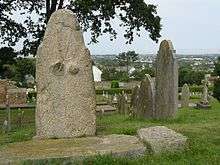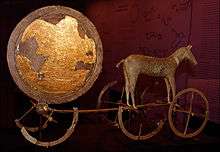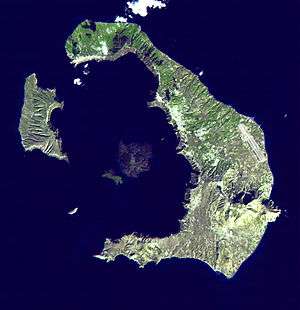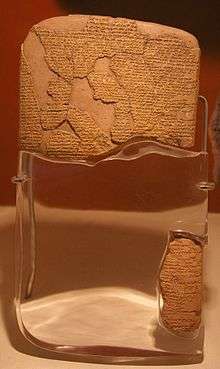2nd millennium BC
| Millennia: | |
|---|---|
| Centuries: |

The 2nd millennium BC spanned the years 2000 through 1001 BC. In the Ancient Near East, it marks the transition from the Middle to the Late Bronze Age. The Ancient Near Eastern cultures are well within the historical era: The first half of the millennium is dominated by the Middle Kingdom of Egypt and Babylonia. The alphabet develops. At the center of the millennium, a new order emerges with Minoan Greek dominance of the Aegean and the rise of the Hittite Empire. The end of the millennium sees the Bronze Age collapse and the transition to the Iron Age.
Other regions of the world are still in the prehistoric period. In Europe, the Beaker culture introduces the Bronze Age, presumably associated with Indo-European expansion. The Indo-Iranian expansion reaches the Iranian plateau and onto the Indian subcontinent (Vedic India), propagating the use of the chariot. Mesoamerica enters the Pre-Classic (Olmec) period. North America is in the late Archaic stage. In Maritime Southeast Asia, the Austronesian expansion reaches Micronesia. In Sub-Saharan Africa, the Bantu expansion begins.
World population rises steadily, possibly surpassing the 100 million mark for the first time.[1]
Old World Bronze Age
| Bronze Age |
| ↑ Chalcolithic |
|
Near East (c. 3300–1200 BC) South Asia (c. 3300–1200 BC) Europe (c. 3200–600 BC)
East Asia (c. 2000–300 BC) |
| ↓Iron Age |
|
Please see the article on Chronology of the ancient Near East for a discussion regarding the accuracy and resolution of dates for events of the 2nd millennium BC in the Near East (Babylon, etc.).
Middle Bronze Age
Spending much of their energies in trying to recuperate from the chaotic situation that existed at the turn of the millennium, the most powerful civilizations of the time, Egypt and Mesopotamia, turned their attention to more modest goals. The Pharaohs of the Middle Kingdom of Egypt and their contemporary Kings of Babylon, of Amorite origin, brought good governance without much tyranny, and favoured elegant art and architecture. Farther east, the Indus Valley civilization was in a period of decline, possibly as a result of intense, ruinous flooding.
Egypt and Babylonia's military tactics were still based on foot soldiers transporting their equipment on donkeys. Combined with a weak economy and difficulty in maintaining order, this was a fragile situation that crumbled under the pressure of external forces they could not oppose.
Unrest of the 16th century
About a century before the middle of the millennium, bands of Indo-European invaders came from the Central Asian plains and swept through Western Asia and Northeast Africa. They were riding fast two-wheeled chariots powered by horses, a system of weaponry developed earlier in the context of plains warfare. This tool of war was unknown among the classical civilizations. Egypt and Babylonia's foot soldiers were unable to defend against the invaders: in 1630 BC, the Hyksos swept into the Nile Delta, and in 1595 BC, the Hittites swept into Mesopotamia.
Late Bronze Age
The people in place were quick to adapt to the new tactics, and a new international situation resulted from the change. Though during most of the second half of the 2nd millennium BC several regional powers competed relentlessly for hegemony, many developments occurred: there was new emphasis on grandiose architecture, new clothing fashions, vivid diplomatic correspondence on clay tablets, renewed economic exchanges, and the New Kingdom of Egypt played the role of the main superpower. Among the great states of the time, only Babylon refrained from taking part in battles, mainly due to its new position as the world's religious and intellectual capital.
The Bronze Age civilization at its final period of time, displayed all its characteristic social traits: low level of urbanization, small cities centered on temples or royal palaces, strict separation of classes between an illiterate mass of peasants and craftsmen, and a powerful military elite, knowledge of writing and education reserved to a tiny minority of scribes, and pronounced aristocratic life.
Near the end of the 2nd millennium BC, new waves of barbarians, this time riding on horseback, wholly destroyed the Bronze Age world, and were to be followed by waves of social changes that marked the beginning of different times. Also contributing to the changes were the Sea Peoples, ship-faring raiders of the Mediterranean.
Empires and dynasties
Significant people
Most people known by name from this period are kings or emperors:
- First Babylonian Dynasty: Hammurabi (1810–1750 BC middle chronology)
- Middle Assyrian Empire: see List of Assyrian kings
- Ancient Egypt: see list of pharaohs
- Bronze Age China: Shang dynasty, Zhou dynasty
An exception is may be Sinhue, protagonist of an Egyptian tale set in the 20th century BC, although the general consensus considers him a fictional character.
Prehistoric cultures
- Europe
Europe is still entirely within the prehistoric era; much of Europe enters the Bronze Age early in the 2nd millennium.
- Aegean civilization
- Beaker culture
- Terramare culture
- Tumulus culture
- Unetice culture
- Urnfield culture
- Central Asia
- East Asia
- South Asia
- Americas
- Sub-Saharan Africa
The desiccation of the Sahara is complete. Neolithisation of Sub-Saharan Africa is initiated via expansion from the dried Sahara, reaching West and East Africa. Later in the 2nd millennium, pastoralism is spread to Central Africa via the Bantu migration. Iron metallurgy in Africa may arise towards the end of the millennium.
Events
- c. 2000 BC—Seima-Turbino Phenomenon[3]
- c. 1700 BC–1300 BC—Palace complex in Knossos, Crete, was built.
- c. 1700 BC earthquake damages palaces at Knossos and Phaistos.
- 1627 BC Minoan eruption
- c. 1600 BC–1360 BC Egyptian domination over Canaan and Syria.
- c. 1575 BC Nubian Kerma sacks Egypt.
- 1520 BC Egypt conquers Nubia.
- 1478 BC Battle of Megiddo
- 1269 BC Ramses II and Hattusilis III sign peace treaty.
- 1274 BC Battle of Kadesh
- c. 1250 BC destruction of Troy VII
- 1045 BC Zhou Dynasty founded in China.




Inventions, discoveries, introductions
- Chinese Oracle bone script
- Phoenician alphabet
- Nebra sky disk, oldest known visual representation of the cosmos
- Chinese record the earliest known sighting of a comet
- discovery of iron smelting and smithing techniques
- Introduction of the Peach from China to Persia and Europe
- wagons
- spoke-wheeled chariots
Languages
In the history of the Egyptian language, the early 2nd millennium saw a transition from Old Egyptian to Middle Egyptian. As the most used written form of the Ancient Egyptian language, it is frequently (incorrectly) referred to simply as "Hieroglyphics".
The earliest attested Indo-European language, the Hittite language, first appears in cuneiform in the 16th century BC (Anitta text), before disappearing from records in the 13th century BC. Hittite is the best known and the most studied language of the extinct Anatolian branch of Indo-European languages.
The first Northwest Semitic language, Ugaritic, is attested in the 14th century BC. The first fully phonemic script Proto-Canaanite developed from Egyptian hieroglyphs, becoming the Phoenician alphabet by 1200 BC. The Phoenician alphabet was spread throughout the mediterranean by Phoenician maritime traders and become one of the most widely used writing systems in the world, and the parent of virtually all alphabetic writing systems. The Phoenician language is also the first Canaanite language, the Northwest Semitic languages spoken by the ancient peoples of the Canaan region: the Israelites, Phoenicians, Amorites, Ammonites, Moabites and Edomites.
Mycenaean Greek, the most ancient attested form of the Greek language, was used on the Greek mainland, Crete and Cyprus in the Mycenaean period.
Centuries and Decades
References
- ↑ Klein Goldewijk, K. , A. Beusen, M. de Vos and G. van Drecht (2011). The HYDE 3.1 spatially explicit database of human induced land use change over the past 12,000 years, Global Ecology and Biogeography20(1): 73-86. doi:10.1111/j.1466-8238.2010.00587.x (pbl.nl). Jean-Noël Biraben, "Essai sur l'évolution du nombre des hommes", Population 34-1 (1979), 13-25 (p. 22) estimates c. 80 million in 2000 BC and c. 100 million at 1200 BC.
- ↑ The Kuru kingdom of the late Vedic period was most likely established around 1200 BC, although there are no datable contemporary references. Pletcher, Kenneth (2010), The History of India, The Rosen Publishing Group
- Samuel, Geoffrey (2010), The Origins of Yoga and Tantra. Indic Religions to the Thirteenth Century, Cambridge University Press
- ↑ Keys, David (January 2009), "Scholars crack the code of an ancient enigma", BBC History Magazine, 10 (1): 9
See also
| Preceded by the Pleistocene |
| Holocene Epoch |
|---|
|
|